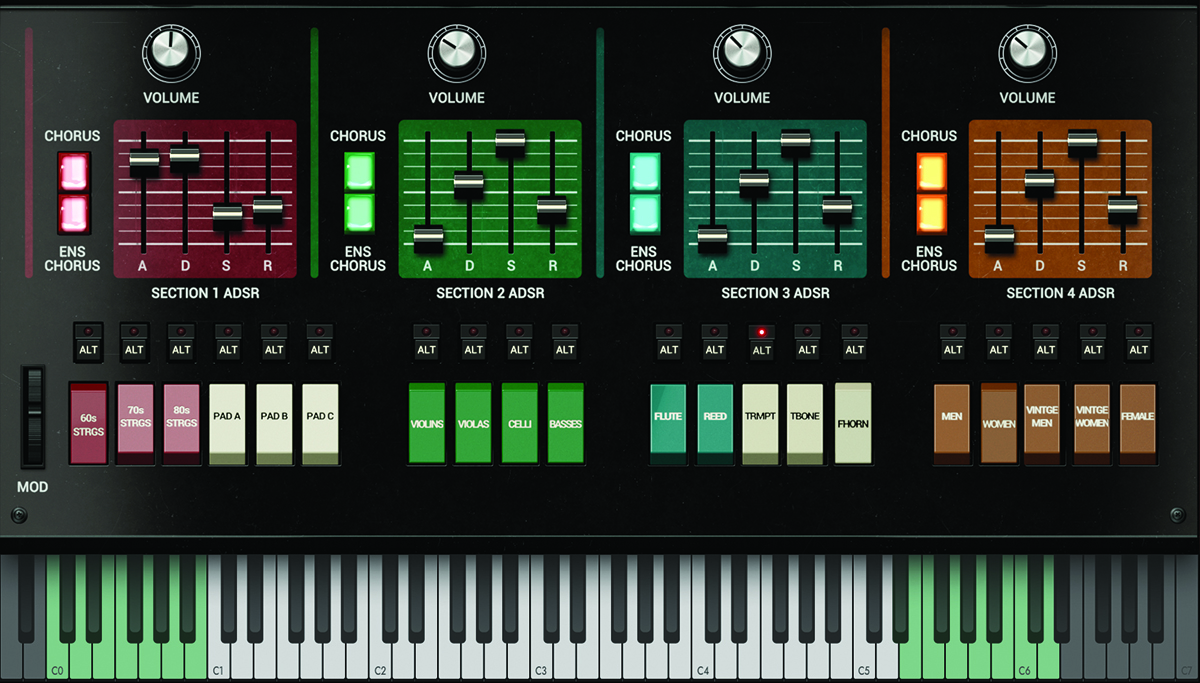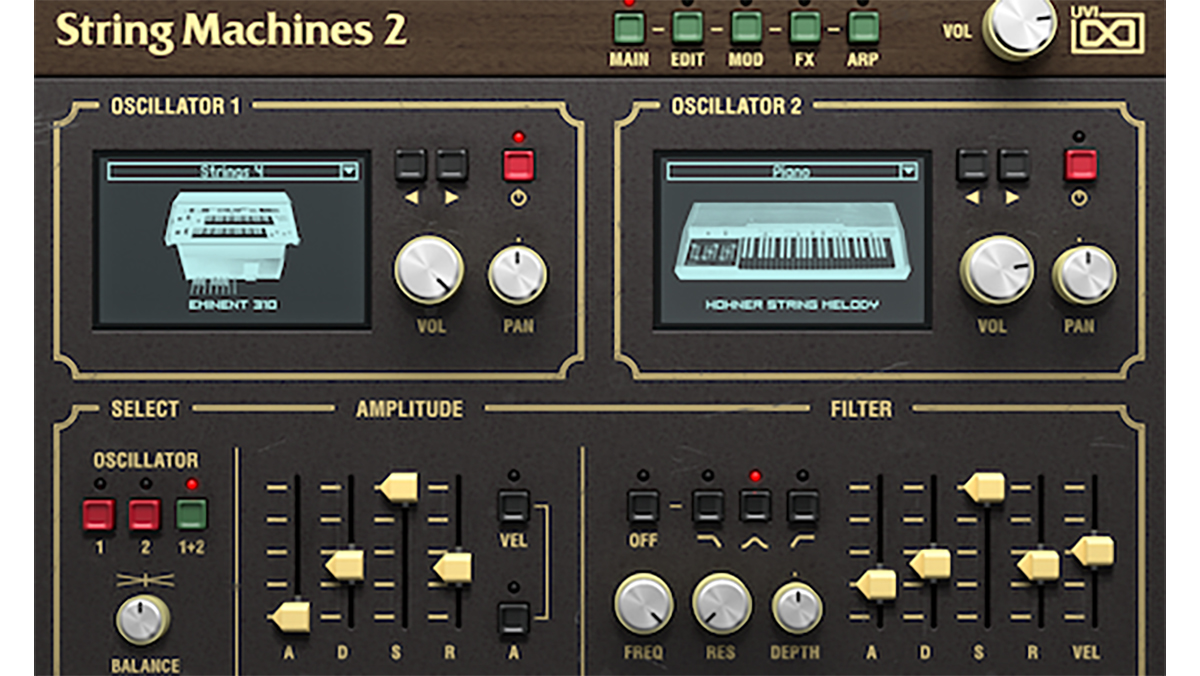MusicRadar Verdict
Colourful and pleasingly authentic, this is an aurally satisfying route in for those looking to get creative.
Pros
- +
Expertly captured authentic string machine sounds.
- +
Era-evocative UI.
- +
A perfect way into the unique mindset of string machine programming.
Cons
- -
More expansive string machine suites are available.
MusicRadar's got your back
EastWest String Machine: What is it?
EastWest’s penchant for pro-level orchestral libraries and malleable vocal suites has made its software stable and a comfortable go-to for many working in the industry. While aimed at serving the needs of modern composers first and foremost, EastWest’s latest in a growing line of more colourful releases gazes warmly back to an age of more basic instrument sampling.
It was a time when analogue synth and string machines, such as the Oberheim OBX, the ARP Solina and the Roland Jupiter-6 were among the most innovative-sounding instruments around. Their scintillating, epic character defined the soundtracks of countless iconic films and tracks from the likes of Giorgio Moroder, Joy Division and Pink Floyd. Intending to emulate the qualities of string ensembles and Hammond organs, the wonky, expansive nature of these synthesised voices instead injected a character all of their own.
Produced by EastWest’s founder Doug Rogers and sample library heavyweight Nick Phoenix, String Machine has been delicately assembled via delicately sampling and modelling the aforementioned instruments. The result encourages you to dig in and make up your own lush, layered pads and voices.

EastWest String Machine: Performance and verdict
Installation via EastWest’s slick control centre is swift, and opening within its now familiar Opus framework means we’re on comfortable ground straightaway. The UI of the instrument itself is pleasingly old-school, with a real instrument-aping aesthetic.

• UVI String Machines 2
UVI’s attempt at building virtual classic string engine is similarly modelled on real instruments.
• GForce Virtual String Machine
If you’re on a budget, look no further than GForce’s modern classic spin, the first of a kind.
Navigation might take a while to grasp for those unfamiliar with the chunky, switch-heavy layout of those vintage pieces of kit. Thankfully, 17 presets are on hand to demonstrate the breadth of timbres this suite can conjure. Most have mod-wheel mapped modulation and expression controls, typically suggesting that you let your wheels glide between various sound sources, alter dynamics and scale filter cutoff accordingly.
The UI displays four colour-coded instrument sections. These consist of String Machines and Pads (Red), String Sections (Green), Solo Woodwinds and Brass (Teal) and Solo Vocals (Orange), these can be combined in a range of ways. Within each section are controls for Volume, Effects, ADSR Envelope Sliders and individual Instrument on/off switches. While cumbersome compared to more modern approaches, this approach mirrors the physical simplicity of the machines themselves. There are also alternatives to each instrument, switchable by clicking the small Alt button above the main instrument switch.
A major piece of the character of these classic string machines was the distinctive ensemble chorus effect, something which String Machine is keen for you to activate, taking its flavouring cues from the ARP Solina and Roland VP-330. It sounds both authentic and meaty when applied to our demo patch.

Get with the times
Alongside ensemble chorus effects modelled on the ARP Solina and the Roland VP-330, String Machine features a Modern mode. This approach makes the sonics more up-to-date, resulting in a less pronounced chorus that blends in better with more densely packed arrangements.
The chorus type can be changed by heading over to Opus’s mix page, where you can also find controls for the insert effects on each selected channel, Volume faders for the four instrument sections, four FX Bus channels and your master channel.
In the Mix section, you can more precisely build the intensity of your patch’s textures. More basic knobs for section volume and overall patch balance and stereo positioning are found on the main Play tab. While these can be good to roughly scale your String Machine sound, it’s recommended that you do most of your fine-tuning within the Mix section, before you apply your String Machine patch to a bigger project.
String theory
While wading in the waters of vintage string machines might not be your first impulse as a composer or sound designer, there’s a lot of superb sonic material here that can enhance a mix. Particularly if your tracks lean more into the atmospheric or ethereal side.
The choirs in particular are among the most effective vocal pads we’ve yet used (especially the Vintage Choirs). Mod wheel scaling of the vowel sounds can add further humanisation, while stacked up alongside retro string machines and pads imparts that characteristic old-school feel. It’s just plain nice.
The ensemble chorus effect sounds both authentic and meaty when applied to our demo patch
While not the deepest or the most comprehensive string machine plugin we’ve encountered (UVI’s String Machines 2 might take the crown there) it’s arguably the best-sounding reproduction of this vintage mood-setter going.
Whether you’re morphing between instrument layers, and subtly augmenting your classic-toned pads, or building up a brash, ensemble chorus-activated central hook, EastWest’s String Machine option is a rich-sounding, faithful reproduction.
MusicRadar verdict: Colourful and pleasingly authentic, this is an aurally satisfying route in for those looking to get creative.
EastWest String Machine: The web says
"Despite being overpriced as a standalone purchase, String Machine stands out for two simple reasons: it sounds superb and it’s fun to use."
MusicTech
EastWest String Machine: Hands-on demos
EastWest Sounds
Dom Sigalas
Anthany Li
EastWest String Machine: Specifications
- MINIMUM SYSTEM: CPU: Quad-core (four cores), running at 2.7 GHz (or above). RAM: 16 GB. OS: macOS 10.13 (or later); Windows 10 with ASIO sound drivers. Drive: HDD (7200 rpm, non-energy saving).
- RECOMMENDED SYSTEM: CPU: Octa-core (eight cores), running at 2.7 GHz (or above). RAM: 32 GB or more. OS: macOS 10.13 (or later); Windows 10 with ASIO sound drivers. Drive: SSD (SATA or PCIe).
- CONTACT: EastWest

I'm the Music-Making Editor of MusicRadar, and I am keen to explore the stories that affect all music-makers - whether they're just starting or are at an advanced level. I write, commission and edit content around the wider world of music creation, as well as penning deep-dives into the essentials of production, genre and theory. As the former editor of Computer Music, I aim to bring the same knowledge and experience that underpinned that magazine to the editorial I write, but I'm very eager to engage with new and emerging writers to cover the topics that resonate with them. My career has included editing MusicTech magazine and website, consulting on SEO/editorial practice and writing about music-making and listening for titles such as NME, Classic Pop, Audio Media International, Guitar.com and Uncut. When I'm not writing about music, I'm making it. I release tracks under the name ALP.
